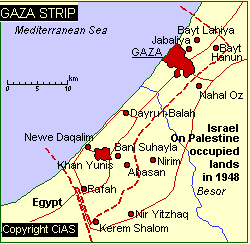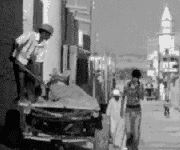



Principal city of the Gaza Strip. Gaza is located on the coast of the
Mediterranean Sea, north of the Sinai Peninsula and southwest of Jerusalem.
A city of historical and religious importance, Gaza has been disputed since
ancient times. Along with the rest of the Gaza Strip, Gaza came under
Israeli occupation in 1967. In May 1994 the city became the headquarters of
the new Palestinian Authority, which administers Palestinian areas in the
Gaza Strip and West Bank.
Gaza is the economic center for a region in which citrus fruits and other
crops are grown. The city contains some small industry, including textiles
and food processing. A variety of wares are sold in Gaza's street bazaars,
including carpets, pottery, wicker furniture, and cotton clothing;
commercial development in the city is minimal. Gaza serves as a
transportation hub for the Gaza Strip, and contains a small port that
serves a local fishing fleet. Points of interest in Gaza include the Great
Mosque and Al Jundi, or the Square of the Unknown Soldier, built by the
Egyptian army.
Gaza's population is composed entirely of Muslim Palestinian Arabs. A
massive influx of Palestinian refugees swelled Gaza's population after the
1948 Arab Israeli war . By 1967 the population had grown to about six times
its 1948 size. The city's population has continued to increase since that
time, and poverty, unemployment, and poor living conditions are widespread.
Gaza has serious deficiencies in housing and infrastructure, and an
inadequate sewage system has contributed to serious problems of hygiene and
public health.
Strategically located on the Mediterranean coastal route, ancient Gaza was
a prosperous trade center and a stop on the caravan route between Egypt and
Syria. The city was occupied by Egypt around the 15th century BC.
Philistines settled the area several hundred years later, and Gaza became
one of their chief cities.
Gaza was captured by Arabs in the AD 600s. Believed to be the site where
the Prophet Muhammad's great grandfather was buried, the city became an
important Islamic center . In the 12th century Gaza was taken by Christian
Crusaders, it returned to Muslim control in 1187. The city fell to the
Ottomans in the 16th century and was taken by the British during World War
I (1914-1918).
Following World War I, Gaza became part of the British mandate for
Palestine. After the first Arab Israel war in 1948, Egypt took control over
Gaza and its surrounding area. Israel occupied the city and the Gaza Strip
during the 1967 Six Day War, and Gaza remained under Israeli administration
for the next 27 years.
With the onset of the Palestinian uprising known as the intifada in 1987,
Gaza became a center of political unrest and confrontation between Israelis
and Palestinians, and economic conditions in the city worsened.
In September 1993 leaders of Israel and the Palestine Liberation
Organization (PLO) signed a peace agreement calling for Palestinian
administration of the Gaza Strip and the West Bank town of Jericho, which
was implemented in May 1994. Most of the Israeli forces left Gaza, leaving
a new Palestinian Authority to administer and police the city, along with
the rest of the Gaza Strip and Jericho. The Palestinian Authority, led by
Yasser Arafat, chose Gaza as its first provincial headquarters. In
September 1995 Israel and the PLO signed a second peace agreement extending
the Palestinian Authority to some West Bank towns . The agreement also
established an elected 88-member Palestinian Council, which held its
inaugural session in Gaza in March 1996.
